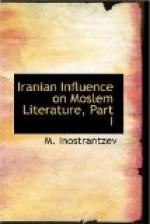CHAPTER V
The Taj Nameh as mentioned in the Fihrist page 305, and page 118, and repeatedly referred to in the Uyunal Akhbar, Part I, of Ibn Kutayba 65
The Persian book with illustrations mentioned by Masudi in his Kitab at Tambih, page 106-7 and the illustrations in the scrolls in the castle of Shiz 68
PAHLAVI BOOKS STUDIED BY ARAB AUTHORS.
We have indicated in the preceding chapter the translations of Ibn al Muqaffa from Persian books into Arabic. Besides those of an ethico-didactic contents, among them there were books of historical character. All these translations have not come down to us. Extracts of these renderings into Arabic, however, have been preserved in the original and sometimes in paraphrase. Unusually important was the translation of the book called the Khuday Nameh, the value of which has long been appreciated by science. Questions of vital importance in connection with this history are its relation to the Shah Nameh and the examination of its various translations in the Musalman period. The loss of this book, perhaps the most important monument of Middle Persian literature, is to be particularly deplored in that with it has perished the connecting link of the historical evolution of Iran, incorporating the religious and clerical legislature in an official redaction. Of capital importance also was another book called the Ain Nameh[1] or the Book of Institutes, a valuable source of the internal history of the Sasanian Empire, comprising a descriptive table of official dignitaries or the Gah Nameh.[2] Judging by the clue given in the Fihrist (118,28) it would appear that the Book of Taj also was a historical one since it has been explained that the book treated of the “Acts of Anushirwan.” As a matter of fact, among the books written by the Persians on epic and historical subjects and indexed in the same Fihrist (305, 8-13) has been mentioned the Book of Taj.[3]
[Footnote 1: See below and also my book on The Materials from Arabic sources, &c., 63-66. Like Masudi in his Kitab at Tambih, Asadi in his Lughal al-Furs (Asadi’s neupersischen Worterbuch Lughat al-Furs, edited by P. Horn, 1897, 110, 1), identifies the word ain with the word rasam, practice or custom. As regards the word ain in the Iranian languages see Horn Grundriss der neu persischen Etymologie, 15-16; Hubschmann, Persische Studien 11, and B.G.A. IV, 175, and VIII, Glossarium IX. To understand the ancient usage of the term the modern Parsi expression Dad wa ain din in the sense of religious law and custom helps us. In this phrase the word dad corresponds to the modern Musalman shariyat and the word ain to adat. Regarding its special meaning in the Umayyad times see J. Wellhausen Das Arabische Reich und sein Sturz 189.]




